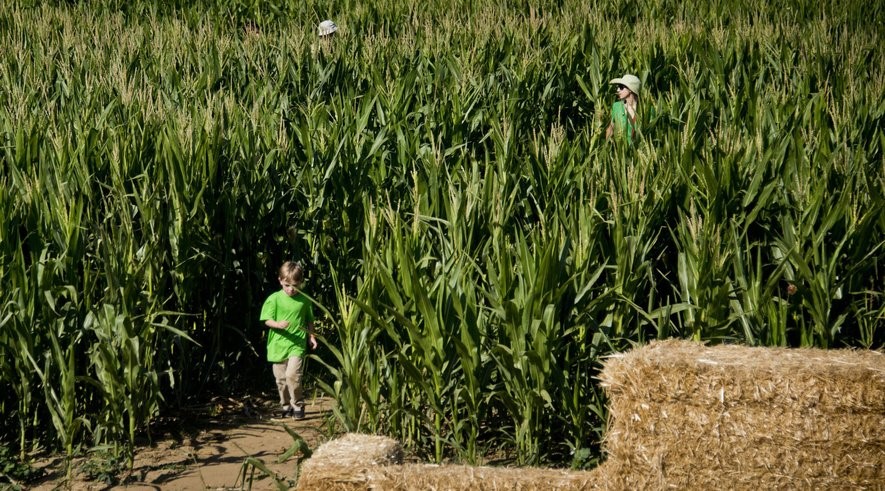The World We Live In: Corn mazes become big business for small farms

Visitors find their way in a corn maze at Dave’s Pumpkin Patch in West Sacramento, Calif., Oct. 11, 2013. What were once sideshows for family farms are becoming agritainment, turning agriculture into entertainment for non-farming folk. Manny Crisostomo/Sacramento Bee/MCT
By The Sacrameto Bee, adapted by Newsela staff
SACRAMENTO, Calif. – Dave Vierra started small. He planted his first corn maze 12 years ago as a sideshow to his popular pumpkin patch in West Sacramento. It covered a mere half acre.
But just like field corn, it quickly grew — and grew. Now, Dave’s Pumpkin Patch and Cornival boasts two corn mazes. The larger maze uses 10 acres as a canvas. The other 2 acres of maze are “haunted” for weekend tours, staffed by more than 40 volunteer zombies and other characters.
In addition to the mazes, the Vierra Farm has a 40-by-60-foot air-filled pillow for jumping, corn containers filled with corn for playing in, and hay bales for climbing. The Cornival also features a “Pumpkin Princess Castle,” pig races, pony rides, hay rides and pumpkin chuckin’ cannons, which shoot the gourds 1,500 feet into the air.
“It’s all the stuff we used to do as kids,” said Vierra, a lifelong farmer. “As a kid, you walked into the cornfield at night and a friend would jump out to try and scare you. You’d jump into a pile of straw or climb on top of haystacks; who doesn’t like that? It’s all about fun activities involving farming.”
That’s Agritainment
Agritainment — making agriculture a form of entertainment for the non-farming masses — has become a reason for small family farms to open their gates each fall and invite customers in to do more than just pick pumpkins. And few activities are more popular, or offer more potential profits, than corn mazes.
“It’s a struggle for the small family farm to survive through traditional farming,” said Kamille Combs of The MAiZE Inc., a design and consulting business that creates hundreds of mazes nationwide each Halloween season, including for Dave’s Pumpkin Patch.
“Most of the people we work with are family farmers who have lived on their land for years and years. They’re trying to hold on to that land. There’s definitely a lot of work in trying to set up something like a corn maze, and there’s no guarantee of profit. It’s a lot like farming itself,” Combs said.
The corn-maze craze has spawned businesses that do nothing but help farmers build and operate mazes. Utah-based MAiZE leads that list. The company, which features a portfolio of more than 2,000 finished mazes, negotiates its prices with each farm, charging either a flat fee for services or a percentage of potential profits. For example, Vierra Farms paid “under $2,000” for its two mazes, including $595 for cutting.
“We’ll do more than 250 (mazes) this year,” Combs said. “Every year, we’ve seen more and more mazes springing up.”
Corn mazes may seem like old-fashioned entertainment, but they’ve gone decidedly high-tech. Mazes are designed on a computer, using the corn rows like straight lines on a graph. Often, a GPS is used to map out the trails in growing cornfields, where paths are mowed or tamped down when the corn is ankle high.
One For The Guinness Book
Vierra expects about 30,000 customers to stop by his pumpkin patch by Halloween night. But over the years, competition has grown more fierce, and owners have had to up the “wow factor” with their maze designs.
“When I started, we were the only corn maze around here,” said Vierra, who opened his annual pumpkin patch business 23 years ago. “Now, there are corn mazes all over the place.”
Although it sounds like a generations-old tradition, the Halloween corn maze is a relatively new and all-American phenomenon. It first surfaced in the early 1990s, according to Corn Mazes America, a contractor that specializes in helping farms make mazes. By 2008, more than 800 mazes nationwide had become annual traditions. This year’s count will top 1,000. The highest concentrations are in the Northeast and Great Lakes states.
Most mazes are between 4 and 10 acres. For comparison, a football field measures about 1.3 acres. However, what’s billed as the world’s largest maze, Cool Patch Pumpkins’ 53-acre corn complex, is located in nearby Dixon, Calif. The Guinness Book of World Records officially crowned it the king of all mazes in 2007.
“Thousands have braved the maze over the past few years, so we continue to try and outdo ourselves each season to keep it challenging for our guests,” said co-owner Mark Cooley.
Brothers Matt and Mark Cooley hand-draw their design, then transfer the rough outline to a digital document for cutting and eventually making maps. This year’s design features dozens of interlocking circles around a bracket-like central maze.
“You’ve Got To Keep It Fresh”
At Dave’s Pumpkin Patch, customers expect more every year, Vierra said. This season, he installed a new zip-line attraction over the corn, plus a free photo booth where visitors can snap photos and immediately post them to Facebook.
“People always want something new,” Vierra said. “You’ve got to keep it fresh. It’s like Disneyland always adding rides and attractions. If you stay the same, it can get stale and there’s no reason to come back.”
Maze builders use slow-maturing field corn so the stalks stay green as long as possible. After Halloween, this crop becomes cattle feed. The MAiZE experts estimate that farms can make $5,000 to $50,000 from an average maze, depending on location. By contrast, the yield from an acre of field corn sells for less than $1,000 and costs about $500 to plant.
Mazes involve extra costs, such as insurance and security, that can add thousands to the final price. But farmers view it as another crop with added interest: fun.
“I plant my corn Aug. 13,” said Vierra, who also grows tons of Halloween pumpkins found in local supermarkets and several other crops. “In 60 days, it’s 8 feet tall. That’s perfect for a maze.”

